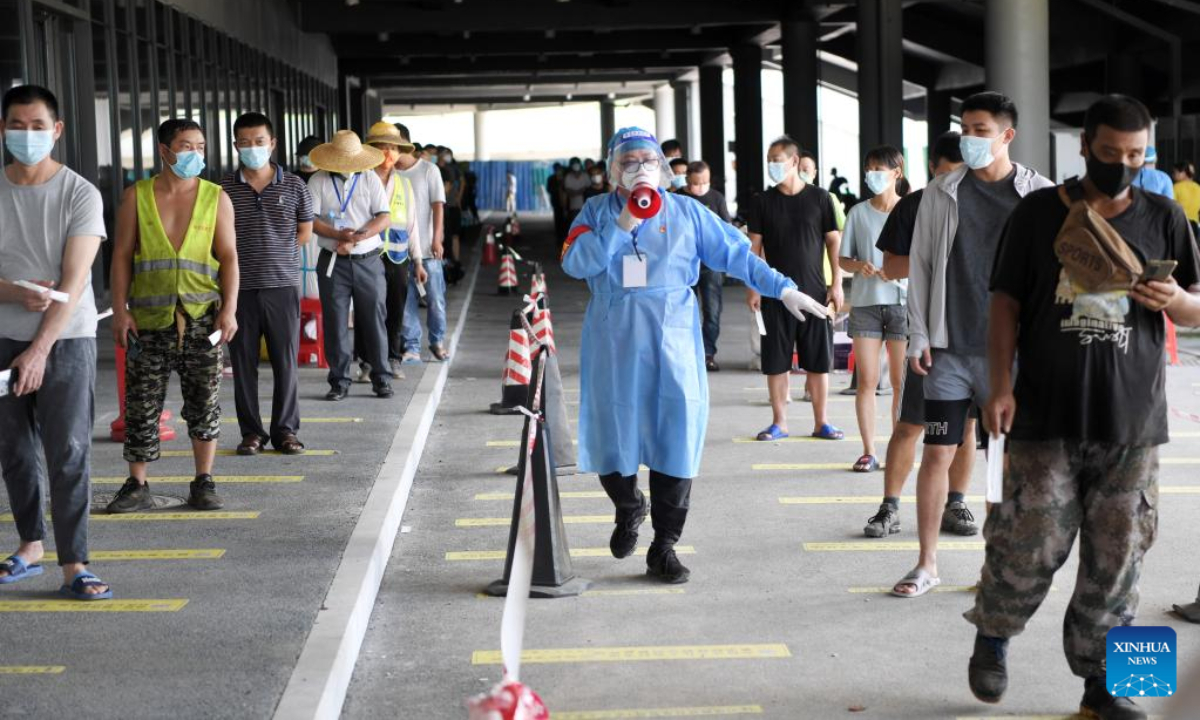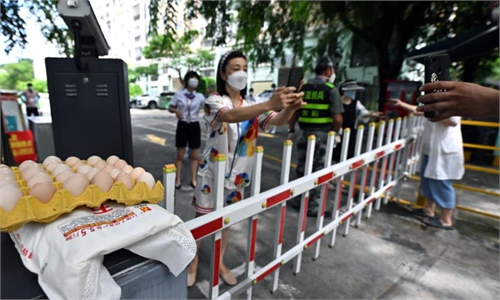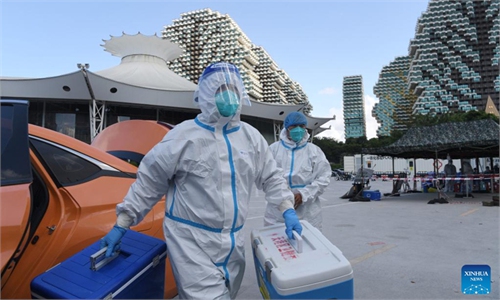
A volunteer works at a nucleic acid testing site in Sanya, south China's Hainan Province, Aug 7, 2022. Prevention and control measures have been taken in Sanya to fight against the new resurgence of COVID-19 in the city. Photo:Xinhua
The wave of flare-ups in South China's Hainan Province is developing rapidly and the province is at a crucial stage to strive for the zero-case goal in communities, local authorities announced on Monday, vowing to extend its static management on fishing ports or related businesses from Tuesday to August 22 as the outbreak in the coastal city of Sanya was likely triggered by imports through the fishery trade.
From August 1 to Sunday, this wave of the outbreak in Hainan has seen 8,883 cases, but the epidemic is generally "under control," Hainan authorities said at Monday's press briefing.
The epidemic in Sanya, dubbed the "Hawaii of China," is still at a high level with case fluctuations. The new cases were detected among people who are mostly under quarantine. Other cities and counties including Danzhou still see epidemics developing, and the risk of spreading still exists in communities, according to the authorities.
Chinese Vice Premier Sun Chunlan has urged swift containment of the latest resurgence in Hainan. Sun on Sunday inspected the central fishing port of Yazhou district, the Sanya international sports industry park and the Sanya epidemiological investigation center, and urged strengthening of nucleic acid testing for early prevention, early detection and early disposal. The central fishing port of Yazhou district was the origin of the outbreak in Sanya.
Sun also called for raising the awareness of fishermen to protect themselves from the virus.
All fishing ports including natural harbors and wharves, and all fishing vessels involved - including fishing auxiliary vessels and recreational fishing vessels - are required to continue implementing static management, according to the authorities.
No fishing vessels shall be allowed to go to sea without permission except for basic navigation services, epidemic prevention and control measures, and emergencies, said the authorities.
A staffer surnamed Chen from a district transportation bureau in Hainan's Danzhou told the Global Times on Monday that all the fishing vessels under the bureau's management are not allowed to go to sea currently, and fishermen are required to suspend work temporarily and take nucleic acid tests once a day.
Lu Hongzhou, head of the Third People's Hospital of Shenzhen, told the Global Times on Monday that the flare-ups in Hainan are being controlled gradually under the current effective measures, including static management over fishing-related businesses.
For the long term, the effective nasal spray vaccines and small-molecule antiviral drugs should be widely promoted to combat the virus, Lu said.
As of Sunday, Hainan had set up more than 13,000 beds in local makeshift hospitals, with 7,913 patients under treatment including three in critical and five in severe conditions.
Hainan also started to resume transportation to ensure stranded tourists could return home. An employee surnamed Chen from Xinhai Port in Haikou told the Global Times on Monday that passengers can leave the island after being quarantined for three days and undergoing three nucleic acid tests.
As of Sunday, 27,211 tourists had left Hainan through Sanya Phoenix International Airport and Haikou Meilan International Airport, returning to destinations including Beijing, Shanghai and Tianjin, according to Monday's press conference. Hainan vowed to prevent the epidemic from spreading to other regions.
People returning to or coming to Beijing from risky areas such as Hainan who receive epidemic-related information including pop-up notifications, or yellow or red health codes, should immediately report to their communities and hotels and follow the related epidemic prevention measures, Liu Xiaofeng, deputy director of the Beijing Center for Disease Prevention and Control, said on Monday's press briefing.
Beijing on Monday reported four local cases among people who returned to or came into the city.


